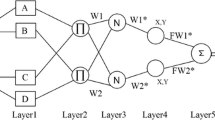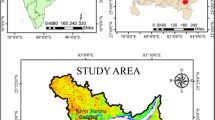Abstract
The application of models capable of estimating sediment transport in sewers has been a frequent practice in the past years. Considering the fact that predicting sediment transport within the sewer is a complex phenomenon, the existing equations used for predicting densimetric Froude number do not present similar results. Using Adaptive Neural Fuzzy Inference System (ANFIS) this article studies sediment transport in sewers. For this purpose, five different dimensionless groups including motion, transport, sediment, transport mode and flow resistance are introduced first and then the effects of various parameters in different groups on the estimation of the densimetric Froude number in the motion group are presented as six different models. To present the models, two states of grid partitioning and sub-clustering were used in Fuzzy Inference System (FIS) generation. Moreover, the training algorithms applied in this article include back propagation and hybrid. The results of the proposed models are compared with the experimental data and the existing equations. The results show that ANFIS models have greater accuracy than the existing sediment transport equations.



Similar content being viewed by others
References
Ab. Ghani A (1993) Sediment Transport in Sewers. Ph.D Thesis, University of Newcastle Upon Tyne, UK.
Ackers JC, Butler D, May RWP (1996) Design of sewers to control sediment problems. Rep No CIRIA 141, Construction Industry Research and Information Association, London.
Azamathulla HMD, Ab. Ghani A, Fei SY (2012) ANFIS - based approach for predicting sediment transport in clean sewer. J Appl Soft Comput 12(3):1227–1230
Azamathulla HMD, Chang CK, Ab. Ghani A, Ariffin J, Zakaria NA, Hasan AA (2009) An ANFIS-based approach for predicting the bed load for moderately sized rivers. J Hydro Environ Res 3(1):35–44
Baghalian S, Bonakdari H, Nazari F, Fazli M (2012) Closed-form solution for flow field in curved channels in comparison with experimental and numerical analyses and Artificial Neural Network. Eng Appl Comput Fluid Mech 6(4):514–526
Bonakdari H, Baghalian S, Nazari F, Fazli M (2011) Numerical analysis and prediction of the velocity field in curved open channel using Artificial Neural Network and Genetic Algorithm. Eng Appl Comput Fluid Mech 5(3):384–396
Chau KW, Wu C, Li Y (2005) Comparison of several flood forecasting models in Yangtze River. J Hydrol Eng 10(6):485–491
Chen W, Chau KW (2006) Intelligent manipulation and calibration of parameters for hydrological models. Int J Enviton Pollut 28(3–4):432–447
Cheng CT, Chau KW, Sun YG, Lin JY (2005) Long-term prediction of discharges in Manwan Reservoir using artificial neural network models. Lect Notes Comput Sci 3498:1040–1045
Chiu S (1994) Fuzzy model identification based on cluster estimation. J Intell Fuzzy Syst 2(3):267–278
Chu HJ, Chang LC (2009) Application of Optimal Control and Fuzzy Theory for Dynamic Groundwater Remediation Design. Water Resour Manage 23(4):647–660
Dawson WC, Wilby R (1998) An artificial neural network approach to rainfall-runoff modelling. Hydrol Sci J 43(1):47–66
Ebtehaj I, Bonakdari H (2013) Evaluation of Sediment Transport in Sewer using Artificial Neural Network. Eng Appl Comput Fluid Mech 7(3):382–392
Ebtehaj I, Bonakdari H, Sharifi A (2014) Design criteria for sediment transport in sewers based on self-cleansing concept. J Zhejiang Univ-SC A, DOI:10.1631/jzus.A1300135. In press
El-Shafie A, Taha MR, Noureldin A (2007) A neuro-fuzzy model for inflow forecasting of the Nile river at Aswan high dam. Water Resour Manage 21(3):533–556
Gopakumar R, Mujumdar PP (2008) A fuzzy dynamic wave routing model. Hydrol Process 22(10):1564–1572
Hanafy TOS (2010) A modified Algorithm to Model Highly Nonlinear System. J Am Sci 6(12):747–759
Haykin S (1998) Neural Networks-A Comprehensive Foundation. Mcmillan College Publishing, New York
Jang JSR (1993) ANFIS: adaptive-network-based fuzzy inference system. IEEE Trans Syst Manage Cybernet 23(3):665–685
Jang JSR, Gulley N (1995) The Fuzzy Logic Toolbox for Use with MATLAB. Natick, MA, The Mathworks Inc.
Jang JSR, Sun CT, Mizutani E (1997) Neuro-Fuzzy and Soft Computing: A Computational Approach to Learning and Machine Intelligence, Prentice-Hall. Upper Saddle River, NJ
Kisi O (2005) Suspended sediment estimation using neuro-fuzzy and neural network approaches. Hydrol Sci J 50(4):683–696
Kisi O, Moghaddam Nia A, Ghafari Gosheh M, Tajabadi MRJ, Ahmadi A (2012) Intermittent Streamflow Forecasting by Using Several Data Driven Techniques. Water Resour Manage 26:457–474
Kisi O, Zounemat-Kermani M (2014) Comparison of Two Different Adaptive Neuro-Fuzzy Inference Systems in Modelling Daily Reference Evapotranspiration. Water Resour Manage 28:2655–2675
Kithsiri MMAU (1990) Sediment transport in rectangular channels with rough rigid beds. Ph.D Thesis, University of Newcastle upon Tyne, UK.
Kitsikoudis V, Sidiropoulos E, Hrissanthou V (2014) Machine Learning Utilization for Bed Load Transport in Gravel-Bed Rivers. Water Resour Manage. doi:10.1007/s11269-014-0706-z
Kolev NP, Chalashkanov NM (2007) Modelling of Partial Discharge Inception and Extinction Voltages Using Adaptive Neuro-Fuzzy Inference System (ANFIS). International Conference on Solid Dielectrics, Winchester, UK, July 8–13.
Kurian CP, George VI, Bhat J, Radhakrishna SA (2006) ANFIS Model for the Time Series Prediction of Interior Daylight Illuminance. Int J Artif Intell Mach learn 6(3):35–40
Macke E (1982) About sediment at low concentrations in partly filled pipes. Mitteilungen, Leichtweiss institut fur Wasserbau der technischen Universitat Braunschweig, Heft 71
May RWP (1993) Sediment transport in pipes and sewers with deposited beds. Hydraulic Research Station. Wallingford, England, Report SR 320
May RWP, Brown PM, Hare GR, Jones KD (1989) Self-cleansing condition for sewers carrying sediment. Hydraulic Research Ltd (Wallingford), Report SR 221
May RWP, Ackers JC, Butler D, Johnt S (1996) Development of design methodology for self-cleansing sewers. Water Sci Technol 33(9):195–205
Mayerle R (1988) Sediment transport in rigid boundary channels. Ph.nThesis, University of Newcastle upon Tyne, UK.
Mayerle R, Nalluri C, Novak P (1991) Sediment transport in rigid bed conveyance. J Hydraul Res 29(4):475–495
Mehta R, Jain SJ (2009) Optimal Operation of a Multi-Purpose Reservoir Using Neuro-Fuzzy Technique. Water Resour Manag 23(3):509–529
Muttil N, Chau K (2006) Neural network and genetic programming for modelling coastal algal blooms. Int J Environ Pollut 28(3–4):223–238
Nalluri C (1985) Sediment transport in rigid boundary channels. Proceeding Euromech 192, Transport of Suspended Solids in Open channels, Neubiberg, Germany:101–104.
Nalluri C, Kithsiri MMAU (1992) Extended data on sediment transport in rigid bed rectangular channel. J Hydraul Res 30(6):851–856
Nalluri C, Ab. Ghani A (1993) Bed load transport without deposition in channels of circular cross section. Proceeding of the sixth International Conference on Urban Storm Drainage. Niagara Falls, Canada
Nalluri C, Ab. Ghani A (1996) Design option for self-cleansing storm sewers. Water Sci Technol 33(9):215–220
Nalluri C, Ab. Ghani A, El-Zaemey AKS (1994) Sediment transport over deposited beds in sewers. Water Sci Technol 29(1–2):125–133
Nourani V, Kisi O, Komasi M (2011) Two hybrid Artificial Intelligence approaches for modeling rainfall-runoff process. J Hydrol 402(1–2):41–59
Novak P, Nalluri C (1975) Sediment transport in smooth fixed bed channels. J Hydraul Division 101(HY9):1139–1154
Ota JJ, Nalluri C (2003) Urban storm sewer design: Approach in consideration of sediments. J Hydraul Res 129(4):291–297
Sanikhani H, Kisi O, Nikpour MR, Dinapashoh Y (2012) Estimation of Daily Pan Evaporation Using Two Different Adaptive Neuro-Fuzzy Computing Techniques. Water Resour Manag 26(15):4347–4365
Sen Z, Altunkaynak A (2006) A comparative fuzzy logic approach to runoff coefficient and runoff estimation. Hydrol Process 20(18):1993–2009
Tahmasebi P, Hezarkhani A (2010) Application of Adaptive Neuro-Fuzzy Inference System for Grade Estimation; Case Study, Sarcheshmeh Porphyry Copper Deposit, Kerman, Iran. Aust J Basic Appl Sci 4(3):408–420
Taormina R, Chau K, Sethi R (2012) Artificial Neural Network simulation of hourly groundwater levels in a coastal aquifer system of the Venice lagoon. Eng Appl Artif Intel 25(8):1670–1676
Valizadeh N, El-Shafie A (2013) Forecasting the Level of Reservoirs Using Multiple Input Fuzzification in ANFIS. Water Resour Manage 27:3319–3331
Vongvisessomjai N, Tingsanchali T, Babel MS (2010) Non-deposition design criteria for sewers with part-full flow. Urban Water J 7(1):61–77
Wu CL, Chau KW, Li YS (2009) Predicting monthly streamflow using data-driven models coupled with data-preprocessing techniques. Water Resour Res 45(8):1–23
Yager RR, Filev DP (1994) Approximate clustering via the mountain method. IEEE Trans Syst Man Cybern 24(8):1279–1284
Yang Z, Liu Y, Li C (2011) Interpolation of missing wind data based on ANFIS. Renew Energ 36(3):993–998
Zadeh LA (1965) Fuzzy sets. Inform Control 8(3):338–353
Author information
Authors and Affiliations
Corresponding author
Rights and permissions
About this article
Cite this article
Ebtehaj, I., Bonakdari, H. Performance Evaluation of Adaptive Neural Fuzzy Inference System for Sediment Transport in Sewers. Water Resour Manage 28, 4765–4779 (2014). https://doi.org/10.1007/s11269-014-0774-0
Received:
Accepted:
Published:
Issue Date:
DOI: https://doi.org/10.1007/s11269-014-0774-0




